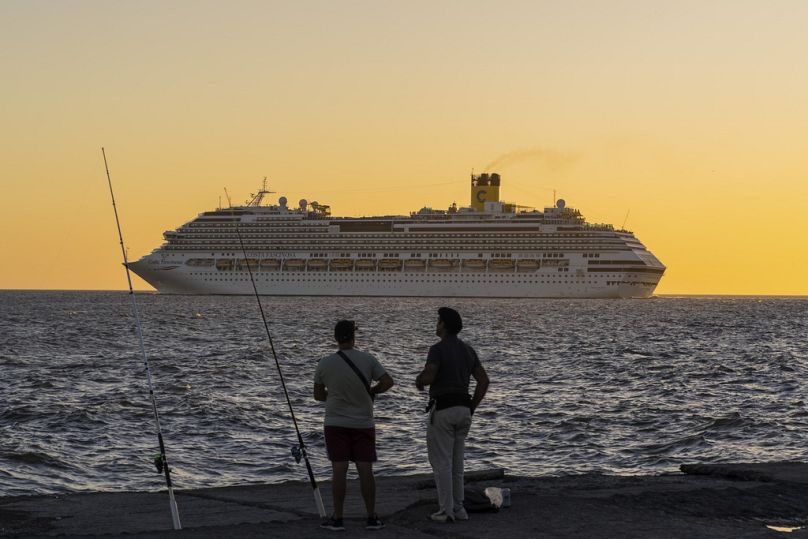Responsible tourism is not only about the physical mode of transport. It’s about being humble and curious. It’s about having respect for people whose homelands we are visiting — all critical to supporting continued progress in innovation in sustainability, Julie Green writes.
Last week, Cruise Port Rotterdam announced that onshore power supply, powered by wind and solar energy, will be available for cruise ships before the end of this year for cruise ships.
Rotterdam is just one of many ports installing the infrastructure as ports work to meet the EU’s regulatory deadline to provide onshore power to ships by 2030.
This technology, introduced by the cruise industry more than 20 years ago, can significantly reduce emissions by allowing ships to switch off engines and plug into an onshore power source to maintain onboard services.
Today, about 50% of all cruise ships have the technology required to plug in at the small percentage of ports that currently have the infrastructure. By 2028, more than 80% of cruise ships will have the ability to “plug in” while in port where onshore power is available.
This is one visible example of how cruise travel is changing as part of a collective effort to achieve net zero emissions by 2050.
In pursuit of this critical target, cruise ships are evolving too—though not in terms of size, as some might believe.
However, since the question of size is on the table, let me say that most cruise ships sailing today (about 70% of the global fleet) are small- to mid-sized ships (3,000 passengers or less), and this ratio is expected to remain the same well into the foreseeable future.
What's new about cruise ships?
What is different about the cruise ships of today and tomorrow is the increasing number of ships being retrofitted and new ships being launched with cutting-edge technologies that are helping to make them the most energy-efficient and environmentally focused ships in the cruise fleet in history, regardless of size.
Cruise lines are investing billions in new ships and engine technologies that will allow for the use of low- to zero-GHG fuels. Tests are taking place to understand the extent to which fuel cells and batteries can power onboard facilities.
In a joint initiative with industry at the University of Genoa, for example, researchers working on fuel cells to capture emissions and generate energy are testing different materials and configurations for industrial production.
Multiple pilot projects and sea trials, led by cruise line companies, are testing new types of fuels, including advanced biofuels and synthetic fuels. Ships are being launched that can be powered by green methanol.
These efforts are allowing, for instance, ships operating in Europe, an average reduction of 16% of CO2 emissions per ship. These results indicate a decoupling of our growth from emissions, thanks to many measures already in place.
Full speed into a green future
The availability and scalability of sustainable marine fuels are indeed a challenge. Cruise lines, shipyards, ports, academic institutions, fuel suppliers, engine manufacturers, and the entire supply chain have rolled up their sleeves to tackle the challenge and are making progress.
We, along with NGOs, are calling on governments to support these efforts and help accelerate the transition to the next generation of sustainable fuels by increasing incentives for their development and production.
The many benefits of innovations on cruise ships extend to local communities. To give just one example, last year, one cruise line produced nearly 7 million cubic metres, or 89% of its total freshwater consumption, on board.
The technologies and practices that made this possible are an integral part of many cruise line operations, meaning that they no longer need to rely on external water supplies.
Self-sufficiency is an overlooked value in the sustainability lexicon and may offer a useful model for holiday resorts and other forms of tourism. These types of advancements and collaborations support the kind of innovation needed to create a sustainable future.
Examples of sustainable tourism practices are also found in many cities we visit. The Croatian city of Dubrovnik's "Respect the city" programme, of which the cruise industry is a strong supporter, serves as an important reminder of our responsibilities when we travel.
Responsible tourism is not only about the physical mode of transport. It’s also a mindset.
It’s about being humble and curious. It’s about being ready to learn about different cultures, and it’s about having respect for people whose homelands we are visiting — all of which is critical to supporting continued progress in innovation in sustainability.
And if affording people the opportunity to travel can help to improve mutual understanding along the way, we all benefit.
Julie Green is Deputy Director General, Europe at Cruise Lines International Association.
At Euronews, we believe all views matter. Contact us at view@euronews.com to send pitches or submissions and be part of the conversation.












